On the Path of The MedTrekker – No Simple Feet!
By Judy Barnett
The rare moment that a life-changing experience occurs is when I least anticipate it. I certainly had few expectations when I bought a copy of “The Idiot and the Odyssey: Walking the Mediterranean” by Joel Stratte-McClure in Launceston late last November. But reading the remarkable book, and then meeting the author, changed my life.
Walking is one of my most empowering and favourite activities. Reading about the author’s trek around the shores of the Mediterranean Sea, and immersing myself in “The Idiot’s” many personal and Homeric ruminations, led me to question the inner emotional, spiritual, physical and psychological strengths required to walk up to 50 kilometres a day on uncharted terrain.
What would possess anyone to walk around the world’s largest inland sea? What is it like out there? Could I do it?
I was compelled to contact Joel to offer my perspective on how his richly blended (philosophical, mental, spiritual, historical, personal, literary) travel narrative impacted my life. Much to my delight he then invited me to join his epic quest last May when he was in the midst of MedTrekking 774 kilometres in southern Italy to gather material for the sequel to “The Idiot and the Odyssey.”
A word about Joel before we start our walk. It goes without question that he is a single-minded, highly motivated and focused individual. The incredibly fit and agile 60-year-old boasts calf, quad and butt muscles befitting any 30-year old athlete. Once I joined him, his tenacity and composure immediately reminded me of his hero Odysseus in Homer’s great epic “The Odyssey.” It even occurred to me that he might be a modern day parallel. Could it be that Joel’s quest is the 21st century version of “The Odyssey”? Perhaps, despite a fall in Morocco and an encounter with thieving Gypsies in Italy, he even boasts superhuman powers. Is he a god in disguise (in Greek mythology the powerful gods were known to appear in human form)? Eager to unravel these and other MedTrekking mysteries, I was thrilled to have an opportunity to get up close and personal with this modern day wanderer.
And here, from my MedTrek Diary, is the experience of a day on the path that’s taken him over 5,500 kilometres around the 16,000-kilometre sea.
May 15th, Gioia Tauro to Scilla, 41 kilometres, 11 hours.
When I awoke to what Homer calls a ‘fresh and rosy fingered Dawn,’ I was ready for whatever challenges might lie ahead. The day began with a breakfast of cappuccinos and croissants in Scilla, a rocky outcrop near the toe of the boot of Italy where the six-headed monster in “The Odyssey” devoured Odysseus’s sailors. It was no accident that Joel had set up his latest base camp at the scene of yet another dramatic event in “The Odyssey” (a few weeks before he slept near the Sirens islands and prior to that he’d been hanging out at Circe’s haunt). Setting up a base camp enables him to travel lightly without carrying a larger pack that, besides being heavy, puts limits on crossing deep rivers and climbing steep escarpments.
We caught a 7:30am train north to Gioia Tauro and by 8.30am were at the exact point on the path that Joel had reached the day before.
After only a few steps I noticed that Joel’s calm, pensive and contemplative demeanour was reflected in his walking style. His pace of around five kilometres per hour on flat terrain doesn’t falter.
I had visions of this experienced MedTrekker leaving me in the dust or sand (despite assurances in “The Idiot and the Odyssey” that he never walks faster than his slowest companion) but the opposite was the case. I was the one scampering around, changing tempo, finding myself up ahead and then slowing up to keep in sync with the expert. “What’s wrong with this guy?” I wondered. “Why doesn’t he blast through the distances or set a brisk pace?”
Incidentally, in order to prepare myself physically and mentally for the perceived challenges I had walked, rather briskly, a 16-kilometre soft sand beach in Australia labouring under the weight of a 15-kilogram pack to camp overnight and return the following day. I wanted to be sure that I could show Joel that I’m no MedTrek liability and can handle whatever is thrown at me. The words “overcompensated, miscalculated and misguided” all come to mind.
I had not only ignored the fact that Joel had already been walking for nearly a month, much of it in the rain, but I was also getting my first significant lesson in Med(itation) Trekking. Joel quietly seemed to focus on every breath, every step, clearing and decluttering his mind. So, I eased up and made a mental reminder that I would heed the wise words from Desiderata hanging on my bedroom wall in Australia: “Go placidly amidst the noise and haste and remember what peace there may be in silence.”
The fact that Joel creates his own path brings me to my second significant lesson in MedTrekking. The path around the Mediterranean is unstructured, unchartered and unique on each and every day. In fact there is no path! The ideal would be firm sand all around the sea but the reality is variable topography and walking conditions that include rivers, marshes, beaches, cliffs, fields, railway lines, urban areas and ports. Combined with encountering an array of people, animals and all kinds of weather conditions, the only constant is unpredictability.
I also began to understand an omnipresent theme in “The Idiot”: the goal is the path the path the goal. Initially it appeared to me that contemplating a 16,000 kilometre walk in a human lifetime would be so daunting that it would be impossible to get through each trekking day without being overwhelmed by the enormity of the undertaking. But Joel didn’t seem to look much further than the next step and seemed unperturbed that he didn’t know what was around the next corner.
The path threw up many challenges on the day we hiked together. Only thirty minutes into the walk was a wide river to ford. Joel took off his clothes, tested the depth and found a sandbar where we could cross without getting completely soaked. That prevented a long walk upstream to a bridge that would have added several kilometres to the day’s walk.
Next we met jagged and rocky cliffs. Do we scale, hop, climb and traverse the cliffs? And how far do they go? Will we get into difficulties and have to turn back if conditions become too problematic? Joel unflinchingly led the way across a precarious cliff traverse that miraculously leads to a stairway and onto a flat beach.
Not wishing to spoil the experience, a word is DEFINITELY required about the beach garbage! The Mediterranean seaside, in southern Italy anyway, is polluted! A beautiful land, beautiful language, beautiful food, beautiful buildings and their beaches south of Naples are literally a garbage dump! In fact this was to be a monotonous sight and so disgusting that I almost, just for a moment, lapsed into a state of complacency to dispose of my garbage in the same fashion. But Joel, who often picks up litter when he walks, simply said that it takes ugliness like this to remind us of beauty.
After 14 kilometres we encountered our first large town and began walking on an urban pathway that presented its own set of issues.
We had to access one beach through private property and navigate our way around a German shepherd in territorial defense mode. Visions of legs, arms and torso being ripped apart to be offered to the gods instantly flashed through my mind. We moved at lightning speed to work our way through a tiny gap in the well fortified gate. Then we continued our omward (prayerful) Trek!
Perhaps the most exhilarating part of this day’s trek resulted from Joel’s decision to climb above the continuously cliffed coastline. The path, this time a switch back overgrown track, led us up and up and up to Monte San Elia at 579 metres above the city of Palmi. Nothing had prepared me for this breathtaking coastline or the fields of undulating green pastures, wildflowers and tilled soil above the huge precipitous cliffs and the sea below.
Our day concluded with another variation on the pathway theme. We trekked the last few kilometres into Scilla alongside the railway line that took us out of town eleven hours earlier. This wasn’t the most exciting part of the trek but it certainly beat the option of hopping on the large rocks between the tracks and sea. On arrival in Scilla, we stopped to marvel at a ceramic depiction of the infamous scene from “The Odyssey” that shows Skylla devouring six of Odysseus’ sailors. Then we had our own leisurely and delicious dinner of seafood risotto on Scilla’s sandy beach before one of the best night’s sleep in my life.
My single day on the path of/with “The Idiot” was a journey taken into the mind, body and soul that left me with much more than I ever anticipated. Among other things, it reawakened my dormant spirit of adventuring. And since returning to Australia I am considering my own midlife project: a walk around Tasmania with “The Idiot and the Odyssey” in my backpack.
Photo Credits: Judy Barnett



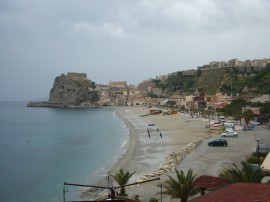
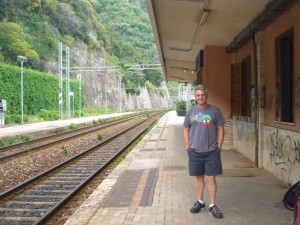

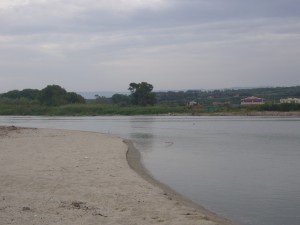
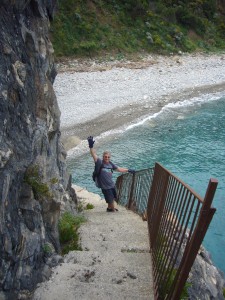

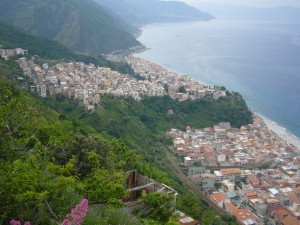
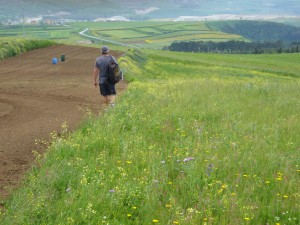

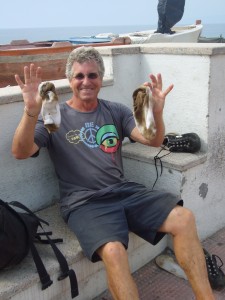

 Follow
Follow